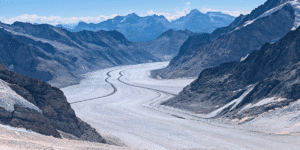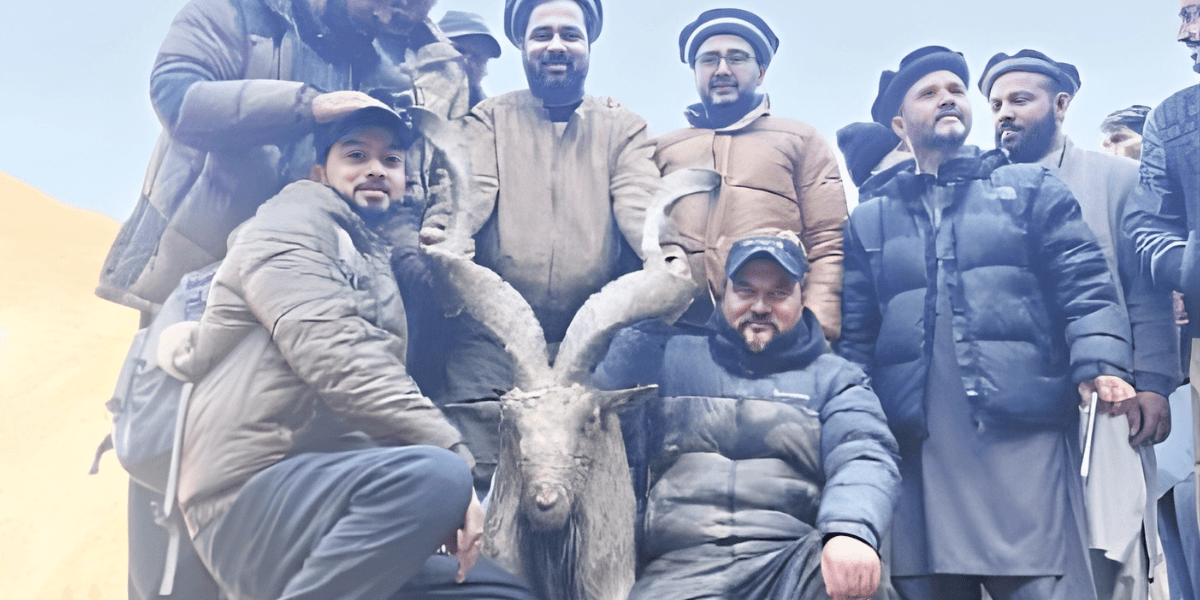People are talking a lot about the beauty of Gilgit Baltistan. But why? What is so special to create hype about it? Why tourists all around are choosing Pakistan’s northern region to spend their vacations? Are there any nature-related views like lakes, mountains, or glaciers in Gilgit-Baltistan?
Well, let me tell you buddy, this province of Pakistan contains everything you have been wondering about! Everything, every thought that has arisen in your mind, the beauty of Gilgit Baltistan answers every single question!
In this guide, you will get a thorough overview of the glaciers of Gilgit Baltistan. So whenever you want to do adventurous activities on these glaciers, you have a perfect guide by your side!
Also, Read Lakes in Gilgit Baltistan – An Overview
Table of Contents
ToggleGlaciers in Gilgit Baltistan – An Overview
Gilgit Baltistan is a territory located in northern Pakistan. It has the highest concentration of glaciers in any region, other than the polar regions. Pakistan alone has over 7,200 glaciers. This makes it an impressive haven, of which close to 3,500 glaciers are found in Gilgit-Baltistan.
Moreover, this region contains three out of the seven largest glaciers in the world, outside the polar region. Such glaciers act as a freshwater resource for the people residing in Gilgit-Baltistan. Additionally, they further export water resources to mainland Pakistan.
List of the Known Glaciers in Gilgit Baltistan
As discussed earlier, Gilgit Baltistan contains quite a great number of glaciers in it. It provides a vast range of a variety of glaciers.
Staying to the main ones, the following is a list of the known glaciers that reside in Gilgit Baltistan
- K2 Glacier
- Passu Glacier
- Rupal Glacier
- Shani Glacier
- Miar Glacier
- Hopar Glacier
- Hispar Glacier
- Baltoro Glacier
- Biafo Gyang Glacier
- Batura Glacier
- Chogo Lungma Glacier
- Bilafond Glacier
- Gondogoro Glacier
- Vigne Glacier
- Trango Glacier
You should also read Skardu in October | Fall Nature’s Masterpiece Awaits!
K2 Glacier
The K2 Glacier is one of the splendid glaciers located in the Karakoram Ranges in Pakistan. It is also known as the Godwin-Austen Glacier. It also stands tall as the second longest glacier in the non-polar region glaciers, measuring a length of about thirty-three miles (57.5 km). This glacier flows down the mountain slope through a warring mountain zone engulfed eventually by the Baltoro glacier. This glacier supplies water for the Hunza River. Hence, it enables people who reside near the area to carry out their economic activities efficiently. It attracts most of the climbers to enjoy the challenging world of the great peaks of Karakoram.

Accessing K2 Glacier
It takes several days to reach this glacier after reaching the major Pakistani city of Skardu by air flight. From Skardu, a trek lasts 5 – 6 days, which is quite challenging. When we reach the Baltoro glacier, the movement does not end with that glacier but more advances. Where the Godwin—Austen glacier is, this part is more advanced and may take extra training owing to the height.
Suitable Time to Visit K2 Glacier
The appropriate time to visit this glacier is during the summer season, estimated from June to August. The weather seems favourable during this time, but unexpected weather situations can also occur.
Do read Hike in K2 Permit and Trekking Fees by GB Govt.
Passu Glacier
The Passu Glacier is a grand glacial construction settled in the Karakoram Range of Pakistan. Being famous for its incredible beauty and lofty peaks, it is an attraction for both trekkers and mountaineers. The unspoiled ice formations, along with the landscapes surrounding it, give rise to an incredibly inspiring spectacle. The glacier stands as a key water source for the local populace and helps maintain the area’s special ecosystem. Due to the serious risks climate change presents to glaciers everywhere, there is a current drive to protect and preserve the Passu Glacier and its environment.
How to approach Passu Glacier?
Travellers must pass through the beautiful Hunza Valley to reach the Passu Glacier, which is in northern Pakistan. The usual way begins in the town of Karimabad, where visitors can secure transport to the Passu village. In Passu, a brief journey brings you to the bottom of the glacier, granting amazing views of its large ice formations and the region’s mountains. The trek is not difficult and adapts well to a variety of fitness levels. Hence it is accessible to a broad spectrum of travelers.
Also, read Do Not Miss Passu Cones Hunza.
Rupal Glacier
The Rupal Glacier resides on the southern end of Nanga Parbat, one of the highest mountains globally and part of the Himalayan Range of Pakistan. About 17 kilometers (11 miles) in length, this glacier lies in the Astore District’s Rupal Valley, forming part of the dramatic landscape. Its origins are from the Rupal Face of Nanga Parbat, famous for its threatening vertical drop, which positions it as one of the world’s tallest rock walls. The Rupal River receives its nourishment from the glacier, which ultimately carries into the Indus River system. The area’s rough attractiveness and challenging pathways for trekking draw visitors as well as mountaineers. While the Rupal Glacier is less famous than glaciers in the Karakoram Range, including the Baltoro and Siachen, it still provides stunning vistas and a feeling of loneliness in an unexplored section of northern Pakistan.
Accessing this Glacier
Access to Rupal Glacier requires, as a first step, traveling to the Astore District in Pakistan’s Gilgit-Baltistan area. The majority of vacationers set off from Islamabad, the capital of Pakistan, either driving or flying. Starting from Skardu, it’s a drive to the town of Taraking, a corridor to the Rupal Valley. Reaching Tarashing is not easy; it requires a tough vehicle, usually a 4×4 jeep. To get to Tarashing, you first need to walk through the lovely Rupal Valley, giving beautiful views of the Rupal Face of Nanga Parbat and the mountains in the area. The hike is mostly challenging, typically lasting some hours to access the glacier, contingent on the weather and how fit you are. On your trip, you will navigate through beautiful fields and traverse streams, which will add value to the journey as well as the destination.
Read Astore Markhor -Facts You Must Know.
Shani Glacier
Shani Glacier is situated in the Naltar Valley of Gilgit District, in Gilgit-Baltistan. At the foot of the western Karakoram Range, the glacier sits around 40 kilometers northwest of Gilgit city. At elevations reaching from 3,200 meters (10,500 feet) to well over 4,800 meters (15,750 feet) above sea level, depending on the locations on the glacier.
Through the summertime, temperatures can vary from 10°C to 20°C (50°F to 68°F), with nights for sure being much cooler. In the winter, the local conditions tend to be a lot more extreme, since temperatures often drop beneath freezing, regularly reaching between -10°C and -20°C (-4°F and -14°F) or colder. Throughout winter, snowfall occurs a lot. Snow and ice keep the glacier out of sight every day of the year.
At this time of year, tourists, trekkers, and adventurers find access to Glacier more convenient, making it possible to appreciate incredible vistas as they happen.
How to Reach it?
Reaching the Shani Glacier requires you to first go to Gilgit, the kickoff point of your expedition. The course kicks off in Gilgit and takes participants 40 kilometers northwest towards Naltar Valley. While there is access to Naltar Valley via road, challenging weather in winter makes it a hard journey. For 2-3 hours, this expedition is usually held by 4×4, unless the roads are narrow and unpaved. Then, you can choose to hike or drive off-road to get to Shani Glacier when you get there in Naltar Valley.
You should read Best Places to Visit in NALTAR Valley.
Miar Glacier
Located in Nagar of Gilgit-Baltistan, Pakistan, is the Miar Glacier. Extending below the impressive Miar Peak (6,824 meters) is a major fragment of the Barpu Glacier. Miar Glacier’s location is at latitude 36° 7′ 4″ N and longitude 74° 50′ 27″ E, resting in the Hoper Valley near breathtaking mountains and unspoiled nature. Being at a high altitude and being in a remote area, the glacier confronts a rough climate complete with cold weather and unforeseeable conditions. In any case, Miar Glacier keeps being a much-loved trip for daring trekkers and mountaineers eager to conquer the tough landscape of the Karakoram Range. Between June and September, this is the perfect time of year to observe Miar Glacier.
Accessing This Piece of Ice
Generally, your experience kickstarts in Gilgit, which allows you to hire local guides. From Gilgit, the path takes trekkers along the Karakoram Highway to Nagar. You will begin a tough several-day trek through the Hoper Valley after leaving Nagar. The trail goes through multiple landscapes, characterized by thick meadows, coniferous woods, and rough moraines. The scenery becomes more challenging as you climb, putting you directly before the Miar Glacier. Having sufficient trekking equipment, enough provisions, and a complete understanding of local weather conditions are important before engaging in this venture.
Hopar Glacier
In the Gilgit Baltistan part of Pakistan, Hopar Glacier is a famous sight often termed Bualtar Glacier. It is found in the beautiful Nagar valleys of the Hopar valley. About 10 km separates Hopar Valley from Nagar Khas, the former primary city of Nagar. Hopar Valley encompasses Barpu Glacier and Mier Glacier as well. Hopar Glacier is visually stunning and unique owing to its black color. From June until September, summer is the ideal time to find enjoyment at Hopar Glacier, thanks to the improved weather conditions that allow easy glacier access. No matter what, it’s important to check the weather forecast and travel advice before you finalize your travel dates.
How to reach this glacier?
One commences the drive down the Karakoram Highway to Nagar, a peaceful village in the Nagar Valley. In Nagar, you will kick off a multi-day excursion that journeys through incredible scenery, with green meadows, thick tree forests, and tall mountains.
The higher you go into the valley, the environment turns markedly more difficult, bringing you near the spectacular Hopar Glacier. The adventure and physical fitness needed for the trek come with rewards that match the level of effort required.
Read this Hopar Glacier Tour Plan | A Comprehensive Guide.
Hispar Glacial System | World’s Longest Glacial System Outside the Polar Region | Glaciers in Gilgit Baltistan
The Hispar Glacier spans about 110 kilometers (68 miles) along the Karakoram Range, in Pakistan. The Biafu glacier meets it at the Hispar La pass. The dominant mountain pass connecting the Gilgit and Hunza valleys, the towering Hispar Pass, is the source location for the glacier. As a result, we ended up creating the world’s longest glacial system found outside of the polar regions.
The stunningness and the obstacles of the terrain at Hispar Glacier draw expert mountaineers and trekkers. At around 4,100 meters (13,450 feet) in altitude at its lower limit, and over 5,000 meters (16,000 feet) at its head, the glacier’s variation produces a tough climate defined by colder temperatures, potent winds, and erratic weather.
Hispar Glacier Access
The route to the Hispar valley in the Hispar Muztagh is perilous and rough. The right bank of the Biafo Glacier is where the Snow Lake and Hispar La Trek trails begin, starting in Skardu and continuing to Askole. The south of Baltoro Glacier hosts a 63 km glacier, which flows into Hispar Glacier.
The trail beginning in Ganish village and winding through Hispar Valley is 41 km in length, a road that is both narrow and unsecured. From October to May, the road is still covered in snow, due to frequent avalanches and landslides. To navigate the steep road, it’s necessary to be in a jeep steered by professional local chauffeurs who know the path well.
Baltoro Glacier
At 62 kilometers, it is one of the longest glaciers outside the polar regions. Part of the Northern Areas of Pakistan, Baltistan is busy through segments of the Karakoram mountain range. Sitting at 8,611 m (28,251 ft), K2 is the highest mountain in the area, and 3 further mountains within 20 km soar over 8,000 m.
The Shigar River starts as a branch of the Indus River thanks to the glacier. Ending their run south from K2, the Godwin Austen Glacier joins the major Baltoro glacier, which receives water from a series of tributary glaciers including the Abruzzi and many Gasherbrum Glaciers coming from the Gasherbrum peaks; along with the Vigne Glacier and others. At the connection of the main Baltoro Glacier with the Godwin Austen Glacier, a site known as Concordia is ideal for travelers alongside the K2 base camp.
Accessing this Glacier
All too often, excursions begin from Skardu, which is the key city of Baltistan. From Skardu, you will embark on a hike spanning several days that navigates the Shigar Valley. The itinerary tracks the Shigar River, going through gorgeous towns, verdant fields, and imposing mountains.
In the upper part of the valley, the ground becomes steadily more rugged leading to Concordia, the intersection of the Baltoro and Godwin Austen glaciers. This is a frequently chosen base camp for climbers and trekkers who wish to investigate the nearby mountain ranges, including K2.
Also, read Discover Karimabad and Hunza
Biafu Gyang Glacier | World’s Longest Glacial System Outside the Polar Region | Glaciers in Gilgit Baltistan
The Biafu Glacier is a glacier that is part of the Karakoram mountain range in the Hisper Valley, Nagar District of Gilgit-Baltistan, Pakistan. It is a considerable length, reaching 67 kilometers (42 miles), and stands as one of the largest glaciers in the full Karakoram range. As covered earlier, it meets the Hispar Glacier to create the longest flow of a glacial system outside the polar regions, at an altitude of 5,128 meters at the Hispar La (pass), giving rise to Snow Lake, which is not a lake but a vast snow basin – one of the largest in the world with a depth of 1,600 meters – from which both the glaciers flow connects.
What’s the best way to engage with the Biafu glacier?
Biafo Glacier is roughly 95 kilometers from the capital city of Gilgit-Baltistan, Skardu. You may get to Skardu by either driving or flying from Islamabad, the metropolitan of Pakistan. From Bifo Glacier, it’s a 7-hour jeep ride to Skardu.
Batura Glacier
The 57 km (35 mi) long Batura Glacier, one of the largest and longest in the world outside the polar regions, lies beyond the polar regions. The upper Hunza (Gojal) part of Hunza District, in Gilgit-Baltistan, Pakistan, is where it is positioned. At 7,795 meters (25,574 ft), Batura is the massif just north of it, and Passu is the nearby massif which rises to 7,500 meters (24,600 ft). The glacier moves from west to east. One may characterize the lower reaches as a dull sea of rocks and patchy gravelly moraine edged by a few summer villages and pastures, seldom without herds of sheep, goats, cows, and occasionally yaks, and abundant with roses and juniper trees.
Journey to Batura
When we hike, we can observe the summer lifestyles of the Wakhi people as they move to summer meadows for their livestock. The start of the actual journey is Islamabad, the contemporary capital of Pakistan, where we take the awesome Karakorum Highway, one of the impressive achievements of humanity, with views that take your breath away of Rakaposhi, Diran Peak, Shishpar peak 7611 meters, Ultar peak 7388 meters, Passu Peak 7478 meters, Karon Koh (7200 meters, and the Batura massive 7500-7785 meters, and so many more.
You would take an interest in Hunza Nagar Cherries | Gilgit-Baltistan
Chogo Lungma Glacier
The Karakorum mountain range, The Shigar District in Gilgit-Baltistan, Pakistan, is where the Chogo Lungma Glacier is located. It was the first among all the major Karakorum glaciers to come to light, in 1835. Entering the land of the giant glaciers of Karakorams from Shigar, Chogho Lungma is the first important glacier to begin calculating the massive quantities in the region. Chogho Lungma conditions Basha River as its foremost tributary, and Basha ultimately runs down and connects with the Braldu River to produce the Shigar River.
From the high and striking Haramosh Peak (7,409 meters/24,308 feet), flows, a mountain located in the Karakoram Range. Off to the east of the famed Rakaposhi Massif, the glacier sits alongside soaring peaks and dramatic ridgelines, giving rise to a remote and isolated setting that is both scary and enchanting for climbers and hikers.
Trek of This Glacier
The path usually begins in the town of Sassi in the Haramosh Valley and heads along the Haramosh La track, leading trekkers into the center of the Karakoram mountains. During the journey, adventurers sweep by quaint villages, lush forests, and expansive pastures, allowing them to see aspects of traditional living in the area. The route then rises to the glacier itself, granting trekkers stunning vistas of the huge ice field, bordering summits, and the calm beauty of its far-flung environment.
Bilafond Glacier
Bilafond Glacier is found within the Siachen region on the other side of the Karakoram Range of Pakistan. This is where we find it in the Ghanche District of Gilgit-Baltistan, Pakistan. The Saltoro River’s subsistence relies mainly on it. At the moment, being in the Siachen region, it is currently under Pakistani management. Its coordinates are 35° 17′ 37″ N and 76° 53′ 17″ E. The glacier’s important location has placed it in the center of the Siachen Conflict, a long-standing territorial argument between India and Pakistan. Due to both its remote position and challenging environmental conditions, the Bilafond Glacier continues to be difficult to access, thus spawning scientific interest as well as geopolitical tensions.
Accessing Bilafond
Due to its remote situation and the challenging accessibility associated with its high altitude, as well as the Siachen Conflict, the Bilafond Glacier is hard to get to. Access demands permits, an appropriate team, and detailed planning for safety purposes.
Access to the glacier is primarily the preserve of military officials and permitted expeditions as a result of its remote situation and the Siachen Conflict.
For those wanting to discover the Karakoram area, you might like to consider trekking to surrounding places like K2 Base Camp or Broad Peak Base Camp.
You would like to read Karakoram Range -All You Need To Know
Gondogoro Glacier
Gondogoro Glacier or Gondoghoro Glacier is one of those glaciers that lies next to Concordia in Gilgit-Baltistan, Pakistan. It is the intersection point of Baltoro Glacier and Godwin-Austen Glacier which offers a substitute way to reach Concordia.
Gondogoro Glacier Access
From Skardu, the jeep road up-to-date takes the trail to Hushe Village. This is a demarcated restricted area. The trek thus crosses into a close-restricted zone and a permit along with permission from the Ministry of Tourism in Islamabad is required. From May to the last week of September, every year comes under the tag of the recommended best season for this trek. The track from Hushe village (3250m) continues northwards, turns east, and then, when turning north again, climbs the Gondogoro Glacier. As a base camp for some peaks developing on both sides of the glacier, Gondogoro is thus reachable.
Vigne Glacier
Vigne Glacier is one of the major glaciers in Gilgit-Baltistan, Pakistan. Being close to Gondogoro Glacier and Baltoro Glacier, it offers an open way to Gondogoro La, a pretty impressive destination by itself, with awesome panoramas of the Karakoram range. It’s a tough trek to Gondogoro La through Vigne Glacier; proper physical fitness and acclimatization are necessary. Still, this great glory of the glacier with its fascinating surrounding peaks makes the journey worthwhile for whoever has the willingness to trudge through the distant and dramatic landscapes of the Karakoram Range.
Trango Glacier
Trango Glacier is a glacier in Baltoro Muztagh, Karakoram range of Baltistan, Gilgit-Baltistan, Pakistan. It is a part of the Baltoro Glacier system which is one of the largest outside the polar regions. It flows from north to south on the western side of the Trango Towers before feeding into the Baltoro Glacier.
The Great Trango Tower was said to be the holder of the world record for the “biggest nearly vertical drop”, standing at a height of 1,340 meters (4,400 ft) tall and 6,286 meters (20,623 ft) total height.
How is Trango Glacier accessed?
It takes several days of hiking from Skardu, Pakistan, to reach Trango Glacier. The visitor arriving in Skardu is immediately faced with a strenuous trek across the Karakoram Mountains, crossing over the Baltoro Glacier and moraine fields. The trek is quite long and requires much preparation, acclimatization, proper gear, and an experienced local guide.
Things to do at Glaciers in Gilgit Baltistan
The glaciers of Gilgit-Baltistan are unique in their breathtaking beauty for anyone on adventure or researching nature. To enjoy the glaciers, consider doing the following
Trek Experience in Glaciers in Gilgit Baltistan
Deep treks in Karakoram Mountains with the peaks of the Karakoram Mountains, mainly Baltoro Glacier Trek, Biafo Glacier Trek, and Hispar Glacier Trek for the extreme beauty of landscapes and tower peaks. You will see intricately carved ice structures, falls cascading from the mountain ranges, and teeming Alpine meadows.
Glacier Hike
Walk onto the glaciers themselves with an accompanied hike for a much more intimate experience. Learn from expert mountaineers as you hike through crevasses, over seracs, and across glacial moraines while they explain how these are formed and function. It’s here that you can hear the crunch of ice underfoot and see at first hand raw unbridled power of nature close by.
Glacier Camping
To feel the glacial environment, pitch your campsite on a glacier camping site. Just imagine falling asleep under the starry night sky, lulled by the soft cracking of ice and the distant rumble of avalanches. Wake to searing sun rises over freshly fallen snow and the peace of the vast wild.
Photography in Glaciers in Gilgit Baltistan
Capture the dramatic beauty of the peaks around the glaciers and the breathtaking sheer beauty of the glaciers through a lens. Dramatic landscapes, the play of lights on ice, and colors create endless numbers of photo opportunities concerning angles, compositions, and lighting of those wonderful glacial environments.
Glacier kayaking
For the more adventurous person, kayaking through the lakes of glaciers would be a must-do. Flow along the glacial lake with towering ice formations and crystal waters on a glacier. Splash your cold water face while exploring hidden coves and secret waterfalls.
Glacier Mountaineering
For the ultimate high, try summiting some of the world’s highest peaks situated near glaciers in Gilgit-Baltistan-K2, Broad Peak, and Gasherbrum II. These expeditions are only for superior physical fitness as well as technical know-how and a healthy respect for the mountain’s power.
Remember while being in Glaciers in Gilgit Baltistan
You have to keep in mind that glacier trekking and mountaineering can be challenging, with an associated risk factor. So proper training, quality equipment, and guidance from experienced professionals are required. Knowing that in your mind, you are sure to find a way to safely explore the wonderful glaciers of Gilgit-Baltistan and cherish memories for all time.
Final thoughts on Glaciers in Gilgit Baltistan
Gilgit-Baltistan, an already very familiar land of enchanting natural beauty, possesses an excellent concentration of glaciers comparable to only polar regions. The region hosts the towering K2 Glacier and the serene Passu Glacier along with a range of other glaciers offering the glacial experience to visitors across the globe. Not only are they contributing as a vital freshwater resource but they also composite the significant components of the water resources of Pakistan.
Whether you are an ardent mountaineer or simply a recreational trekker, the glaciers of Gilgit-Baltistan stand before you like a wide range of possible activities: glacier trekking or hiking, mountaineering, and even glacier kayaking. Just be careful, because otherwise, you need to plan the trip, make sure all your gear is in order, and consult with the professionals and experienced leaders to be able to enjoy the journey. Also, do not forget to share your thoughts about glaciers in Gilgit Baltistan.
Also, read Glacier Grafting
Questions and their Answers related to Glaciers in Gilgit Baltistan
Why glaciers in Gilgit-Baltistan are important?
Glacial sources of Gilgit-Baltistan are vital sources of freshwater supply to the people and an important source of share in water supply in Pakistan.
What is the importance of the K2 Glacier?
The K2 Glacier is also known as the Godwin-Austen Glacier and is the world’s second-largest glacier outside the polar regions and flows from the bottom of K2, the world’s second-highest mountain.
How do tourists reach the Passu Glacier?
Tourists can reach the Passu Glacier by traveling up to Hunza Valley to the town of Karimabad and then a short journey to its base.
What is special about Rupal Glacier?
The scenery of Rupal Glacier is different as it is close to the bottom of Rupal Face of Nanga Parbat-one of the world’s highest rock faces.
What are the inferences from the Shani Glacier?
One of the glaciers that could only be seen in the summer season from high altitudes was Shani Glacier. The glaciers have great scenic beauty, but challenging terrain and extreme winter conditions also exist.
How to access the Miar Glacier?
Travelers and trekkers can continue up to Nagar from here and trek for days up to Hoper Valley before reaching Miar Glacier.
What is so particular about the Hopar Glacier?
The Hopar Glacier is very special with its black color, hence very alluring and also a favorite trekking route with an excellent backdrop of mountains.
Why is the Hispar Glacial System of importance?
This is probably the result of combining Hispar and Biafo glaciers, being one of the longest glacial systems outside polar regions. Extremely challenging destination yet extremely rewarding for hard-core trekkers and mountaineers.
What is Baltoro Glacier in detail?
Baltoro is one of the largest glaciers outside of polar regions and extends up to K2 Base Camp-very famous camp. It surely stands among the most visited glaciers for trekkers and mountaineers.
What is special about the Biafo Gyang Glacier?
Biafo Gyang Glacier is among the most important glaciers of the Karakoram Range, often characterized by hard terrain and shining landscapes. It also forms a part of the Hispar Glacial System.
What is Batura Glacier significant for?
Among the biggest and also longest glaciers outside of polar regions, Batura Glacier is famous for its great views of the peaks surrounding it.
How does the Chogo Lungma Glacier relate to everything?
The Chogo Lungma Glacier is the first big one ever discovered in the Karakoram Range. It is characterized mostly by ragged terrain and breathtaking views.







